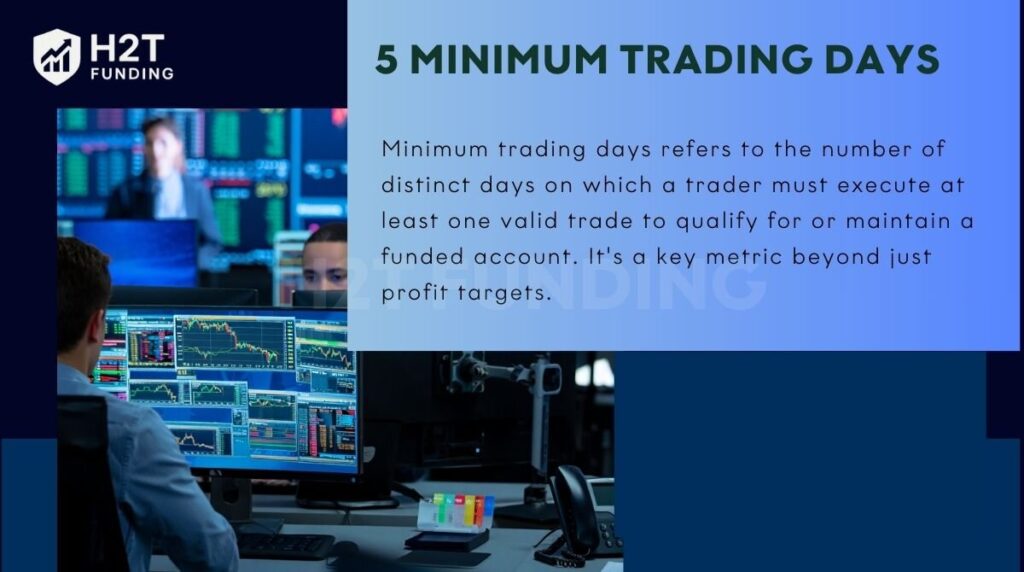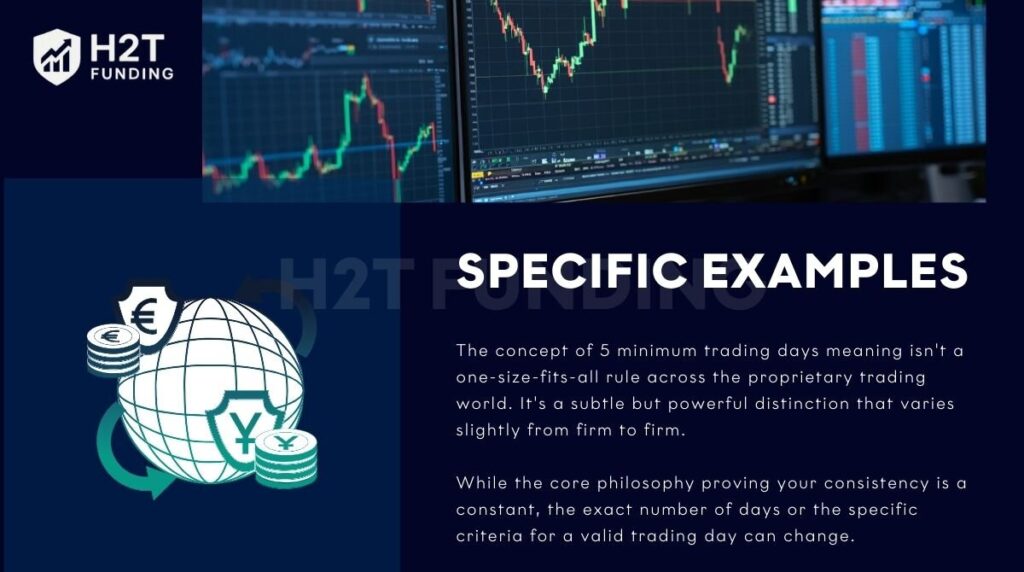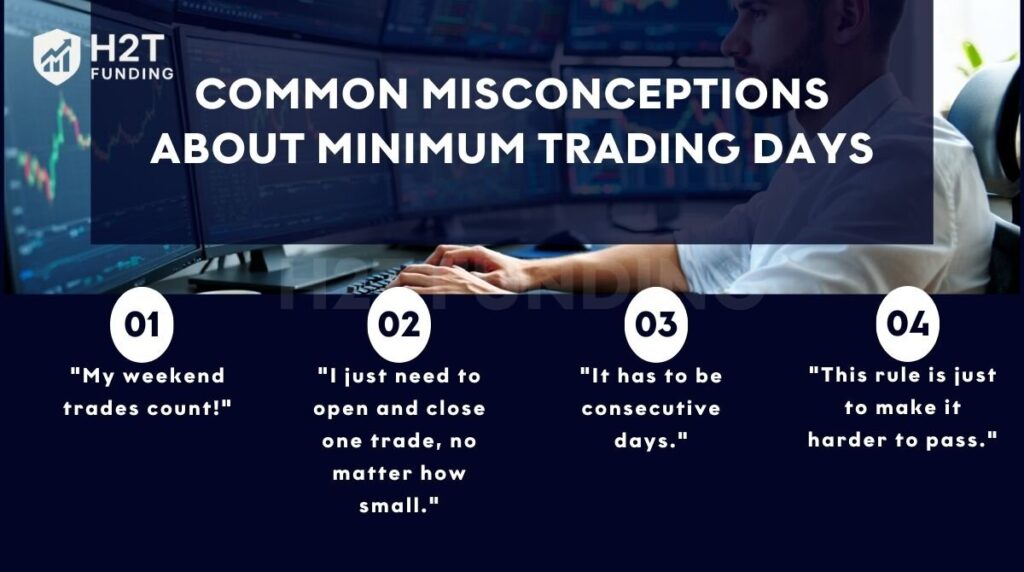Getting tripped up by the fine print of a prop firm challenge is a common frustration for many traders. One rule that consistently confuses is the 5 minimum trading days requirement.
So, what exactly does the 5 minimum trading days mean, and why is it so important? It’s not just a box to tick; understanding this rule is fundamental to your success and can be the difference between getting funded or failing the challenge.
This comprehensive guide will fully unpack the concept of 5 minimum trading days. We’ll explain its precise definition, delve into why prop firms implement it, and provide practical strategies to help you meet this vital condition.
Key takeaways:
- The 5 minimum trading days rule requires traders to execute at least one valid trade on five distinct days during a prop firm challenge, emphasizing active market engagement over mere logins.
- It ensures consistency, evaluates risk management, discourages gambling-like trading, and provides firms with sufficient data for thorough due diligence.
- Traders can meet this requirement by planning daily trades strategically, focusing on quality over quantity, using small positions to minimize risk, and accurately tracking progress based on the firm’s server time.
- Different prop firms like FundedNext, FTMO, and Rocket21 have varying minimum trading day requirements (e.g., 2–10 days), with specifics depending on the challenge or account type.
- Weekend trades don’t count, trading days don’t need to be consecutive, and the rule isn’t just an obstacle; it’s designed to identify disciplined, reliable traders.
1. What exactly does the 5 minimum trading days meaning?
Minimum trading days refers to the number of distinct days on which a trader must execute at least one valid trade to qualify for or maintain a funded account. It’s a key metric beyond just profit targets.

1.1. Clarifying the core definition
A trading day isn’t just any day you decide to check your charts. It’s a powerful indicator of your dedication, a day where active trading unfolds and aligns with the specific, often strict, criteria set by the funding firm. Simply logging in won’t cut it; you have to actively engage, showing the firm you’re not just a spectator but a true participant.
For a day to count as a “valid trading day,” most prop firms demand at least one trade to be opened or closed. Some might even throw in curveballs like a minimum lot size or certain instrument restrictions.
Speaking from experience, the real challenge is that each firm crafts its own unique definition of a ‘trading day.’ The most common rule is that at least one trade must be opened or closed on that day. This isn’t just an arbitrary hurdle; it’s their way of making sure you’re genuinely in the game, not just window shopping.
For instance, if you bravely open a trade on Monday and close it on Tuesday, both Monday and Tuesday could potentially count as separate trading days. But if you open and close a flurry of trades all on Monday, that’s still just one day in their books. The magic lies in the distinct daily activity, proving you’re consistently showing up and putting in the work.
1.2. Why are minimum trading days crucial for traders?
This requirement isn’t just a pointless hurdle; it’s a crucial test that goes far beyond simply hitting a profit target. It’s designed to assess your true grit, your ability to perform consistently, and master risk over time. One lucky trade won’t save you here; this is about proving you’re the real deal.
The rule beautifully emphasizes consistency over sporadic success. It forces you to truly put your strategy to the test against different, ever-changing market conditions. By facing this challenge, you’re not just passing a rule; you’re building the kind of disciplined trading habits that will lead to lasting success. It’s a wake-up call, showing you that real funding comes from genuine, repeatable skill, not random chance.
2. Why do prop firms require minimum trading days?
Proprietary trading firms don’t just hand out capital based on a single impressive trade. They are looking for reliable traders who can manage risk and generate consistent profits over time. The minimum trading day requirement serves several critical purposes in this evaluation.

2.1. Demonstrating consistency, not just luck
This rule acts as a filter, distinguishing traders who can consistently perform from those who might get lucky with a single large win. Prop firms want to see a track record of sustained effort and strategy execution. It’s about proving your method works repeatedly.
It encourages discipline and adherence to a well-defined trading plan. A trader who can meet the minimum trading days while staying within drawdown limits shows a methodical approach, not just impulsive reactions.
2.2. Assessing risk management skills
A trader who consistently engages with the market over several days often demonstrates better risk control. They are likely managing their exposure across various market conditions, rather than taking excessive risks on one trade. This rule indirectly promotes more cautious trading behavior.
It forces traders to experience different market dynamics, from volatile surges to quiet consolidation periods. This exposure helps evaluate how well a trader adapts their risk management strategies to varying environments.
2.3. Preventing a gambling mentality
The minimum trading days requirement helps to discourage a “gambling” mentality. Traders cannot simply make one large, high-risk bet hoping to hit a profit target quickly. This rule demands a more measured and professional approach.
It promotes a long-term perspective in trading. By requiring activity over several days, firms ensure traders are thinking about sustainable growth rather than quick, unsustainable gains. This fosters a more responsible trading mindset.
2.4. Operational & due diligence
From an operational standpoint, this requirement allows prop firms to gather more data on a trader’s behavior. A longer trading history, even if just a few days, provides a clearer picture of their trading style, instrument preferences, and emotional responses to wins and losses. This helps firms conduct thorough due diligence.
It minimizes the risk for the funding company by ensuring that any capital allocation is based on a more robust assessment of a trader’s capabilities. It’s a safeguard against funding traders who might be inconsistent or overly aggressive.
3. Navigating minimum trading days: Strategies for success
Meeting the minimum trading day requirement doesn’t have to be a hurdle. With a thoughtful approach and careful planning, you can easily fulfill this condition while maintaining your trading discipline. It’s about smart execution, not just constant activity.
3.1. Strategic planning for daily activity
To ensure you meet the daily requirement without overtrading, it’s essential to plan your trades strategically. Don’t just open a trade for the sake of it; integrate this requirement into your overall trading plan.
Consider setting a small, consistent daily target, such as executing just one valid trade. This can be particularly useful if your primary goal is to hit the minimum days while waiting for optimal setups for larger positions.
3.2. Focusing on quality over quantity
While meeting the minimum trading days is important, never compromise on the quality of your trades. Forcing trades just to meet the day count can lead to unnecessary losses and undermine your overall progress.
A classic mistake I see traders make, and I’ve been guilty of it myself, is forcing trades just to hit the day count. This almost always leads to poor decisions and avoidable losses. Always stick to your plan, even if it means being patient and waiting.
3.3. Leveraging micro lots/small positions
If you’re nearing your profit target but still need more trading days, using minimal lot sizes or small positions can be an effective strategy. This allows you to fulfill the daily activity requirement while significantly minimizing your risk exposure.
This approach is especially appropriate when market conditions aren’t ideal for your primary strategy, but you still need to log a trading day. It ensures continuous progress without taking on undue risk.
3.4. Tracking your progress accurately
It’s crucial to accurately monitor your trading days to avoid any surprises. Most prop firms provide a dashboard or a clear way to track your progress, including the number of trading days completed.
Always pay close attention to the firm’s server time. A trading day is often counted based on the specific server time, which might differ from your local time zone. This detail is vital for accurate tracking.
4. Specific examples: How leading prop firms define minimum trading days
The concept of 5 minimum trading days meansn’t a one-size-fits-all rule across the proprietary trading world. It’s a subtle but powerful distinction that varies slightly from firm to firm.

While the core philosophy of proving your consistency is a constant, the exact number of days or the specific criteria for a valid trading day can change. Ignoring these nuances is a rookie mistake that can cost you a funded account. It’s absolutely critical to dig into the fine print of any firm you’re considering.
Here’s a look at how some prominent firms define their minimum trading day requirements:
4.1. FundedNext
FundedNext, a titan in the prop firm world, isn’t just about rigid rules; they understand that every trader is different. They’ve built their system with varying minimum trading day requirements, giving you the power to choose a challenge that perfectly fits your style and timeline. This isn’t a one-size-fits-all prison; it’s a flexible pathway to success.
For their Evaluation, Stellar Lite, and Stellar 2-Step Challenges, you’ll need a solid five days of active trading, proving your discipline. But for those ready to sprint, the Stellar 1-Step Challenge offers a lightning-fast assessment with a minimum of just two days.
The real win? Once you’ve conquered a challenge and become a funded trader with an Evaluation, Stellar Lite, or Stellar 2-Step account, the daily pressure is off. You’re free from the minimum trading day requirement, a testament to the trust they place in your proven skill.
Of course, no journey is without its unique paths. Their Express Account model, a remnant for existing clients, demands a more committed 10-day minimum. It’s a reminder that different accounts come with different expectations, but the core promise remains: flexibility and freedom are the rewards for consistency.
4.2. FTMO
FTMO, a true pioneer in the prop trading world, sets a high bar for excellence. They don’t just want traders who get lucky; they demand consistency and discipline through their “Minimum Trading Days” rule. This isn’t a pointless hurdle; it’s your chance to prove you have what it takes during the intense FTMO Challenge and Verification stages.
To conquer this objective, you must execute at least one trade on a minimum of four separate days. The best part? These days don’t need to be consecutive, giving you the flexibility to trade when the market is right for you.
This rule is a brilliant filter, designed to weed out gamblers and identify traders who can consistently manage risk and build steady profits. The reward for your hard work is immense: once you’ve proven your skill and become an FTMO-funded trader, the minimum trading day rule is gone, replaced with the freedom and comfort you’ve earned. It’s a testament to the trust they place in your proven ability.
4.3. Rocket21
Rocket21, like other elite firms, uses minimum trading day requirements as a crucial part of its evaluation. It’s their way of making sure you’re a consistent performer, not a one-hit wonder, and this is especially critical if you’re serious about getting paid.
Once you reach the coveted Simulated Funded Account, you’ll have to prove your dedication with a minimum of five trading days for the Rocket 21 Standard challenges, or a brisk three days for the Apollo11 challenges.
But here’s the most important part of Rocket21’s policy, and it’s a game-changer: the minimum trading days reset after every withdrawal request. This means the pressure is always on you to stay active and engaged before you can pocket your profits.
A trading day is only counted when a new order is opened on a new day, all according to the firm’s server time. It’s a powerful incentive, ensuring you’re an actively participating trader, not just someone collecting a paycheck. This rule is a brilliant safeguard for the firm and a constant challenge for you, pushing you to stay at the top of your game.
4.4. Generalizing from examples
While the specific numbers differ, a common theme emerges across these leading firms regarding 5 minimum trading days, meaning they all prioritize consistent, active engagement over a period. Whether it’s 2, 3, 4, 5, or 10 days, the underlying principle is to evaluate a trader’s discipline and ability to perform reliably.
Always remember to thoroughly check the specific rules of any prop firm you are considering. These requirements are part of their due diligence and are designed to ensure you are a consistent and reliable trader before they entrust you with capital.
5. Common misconceptions about minimum trading days
Even with clear definitions, the concept of minimum trading days can still lead to misunderstandings. Addressing these common misconceptions helps clarify the rule and ensures traders approach it correctly. It’s about dispelling myths to foster better preparation.

5.1. My weekend trades count!
This is a rookie mistake that trips up countless new traders. You might think you’re being clever by placing trades over the weekend, but those trades will never count towards your minimum trading days. The market is typically closed from Friday evening to Sunday evening (server time), and prop firms are unforgiving about this.
Only days when the Forex market is truly open for business and active trading can happen will count. This means your trades have to fall squarely within the firm’s specified trading hours on weekdays. Don’t waste your time; if you’re not trading during the right window, you’re not trading at all.
5.2. I just need to open and close one trade, no matter how small.
While many firms are generous enough to let even a tiny trade count toward a trading day, you’d be a fool to take that for granted. The true spirit of the rule isn’t about ticking a box; it’s about proving you have consistent trading activity, not just making a token gesture.
You absolutely must do your homework. Always, always check the firm’s specific rules for any minimum volume requirements or other hidden conditions. Ignoring the subtle nuances in their definitions is a surefire way to get tripped up, and it could cost you the chance at a funded account. Don’t let a small oversight become a massive failure.
5.3. It has to be consecutive days.
There’s a constant, nagging worry that haunts traders: do the minimum trading days have to be consecutive? Breathe easy, they don’t. For most proprietary trading firms, this is a myth you can safely ignore. The days don’t have to follow each other directly.
You have the incredible freedom to trade on Monday, take a break until Wednesday, and then trade again on Friday. All three of those separate days will count toward your total. This flexibility is a huge win, allowing you to manage your own schedule and, more importantly, wait patiently for the perfect market conditions to align with your strategy. You’re in control, not the clock.
5.4. This rule is just to make it harder to pass.
Some traders tragically see the minimum trading days rule as nothing more than a pointless obstacle, a malicious roadblock thrown up just to make their lives harder. This bitter perspective completely misses the point, blinding them to the rule’s true, powerful purpose.
This rule isn’t a hurdle; it’s a litmus test. It serves a critical purpose: to assess your consistency, to prove your risk management skills, and to show you possess a disciplined approach to trading.
It’s an invaluable tool for prop firms, designed to separate the truly capable traders from the hopeful amateurs. It’s a challenge, yes, but it’s one built to protect you and the firm by ensuring that only the most reliable traders get funded.
Read more:
6. Frequently asked questions (FAQs)
It means you need to execute at least one valid trade on five distinct days during a challenge or evaluation period. These are active trading days, not just calendar days.
In FundedNext, the minimum trading days vary by challenge: 5 days for Evaluation, Stellar Lite, Stellar 2-Step; 2 days for Stellar 1-Step; and 10 days for the Express Account. For funded accounts (excluding Express), there’s generally no minimum.
It signifies that you must trade on at least three separate days. This lower threshold is often seen in specific challenges or for certain account types, like Rocket21’s Apollo11 challenge.
Contrary to the misconception that this is a general term, “Goat Funded Trader” is actually the name of a proprietary trading firm. One of this firm’s standout features is that they often have no minimum trading days requirement for their main challenges. This offers great flexibility for traders. However, for the most accurate and up-to-date information, you should always check the specific rules on their official website before participating.
Minimum trading days in prop firms means the number of distinct days a trader must actively trade (e.g., execute at least one valid trade) during a challenge to qualify for a funded account, ensuring consistent engagement and risk management.
7. Conclusion
In conclusion, understanding the 5 minimum trading days meaning is about more than just mastering a rule; it’s about grasping one of the core evaluation philosophies in the prop firm industry. This requirement is designed to assess your consistency and discipline, not to be a barrier. By approaching this condition strategically, you prove yourself as a reliable trader.
At H2T Funding, we are committed to providing you with comprehensive knowledge to confidently conquer these challenges. To continue delving into effective trading methods and gain a deeper understanding of firm regulations, be sure to explore our Prop Firm & Trading Strategies section. Equipping yourself with knowledge is the key to your sustainable success.





